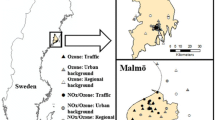Abstract
Ozone levels at Clean Air Status andTrends Network (CASTNet) and nearby rurally-designatedState and Local Air Monitoring Stations (SLAMS) siteslocated in the eastern United States (U.S.) arecompared using daily indicators (i.e., maximum, range,and SUM06) based on hourly O3 measurements. Comparisons are also made using monthly and summertimethree-month SUM06 determinations aggregated from dailydata. Comparison of O3 indicators at the pairedCASTNet-SLAMS sites generally shows better agreementfor O3 maximum than for range or SUM06. Thehighest correlation of daily O3 indicators occursfor paired sites that are separated by less than 100miles, and the correlation diminishes with increasingseparation distance. Correlation coefficients exceed0.70 in 49% of the comparisons of maximum, in23% of range comparisons and in 5% ofSUM06 comparisons, suggesting that substitution ofSLAMS for CASTNet O3 measurements would fail tocapture a substantial amount of the variability inO3 indicators present at the CASTNet sites. Correlations of O3 indicators at CASTNet andpaired nearby SLAMS sites are ≥0.80 in a relativelysmall number of cases. Despite the high correlationin even these cases, O3 behavior at paired sitesis not identical and shows systematic differences thatare reflected in the O3 minimum, hourly averageconcentrations, and the monthly and three-month SUM06. Ozone measurements at nearby rurally-designated SLAMSsites may not capture the `rural' nature of the airquality being monitored at CASTNet sites and, in mostcases, may not be sufficiently representative of theconcentration at CASTNet sites to permit O3measurements at SLAMS sites to be used in lieu ofmeasurements at CASTNet sites. As a result, if ruralO3 concentration data are needed, then O3monitoring at carefully chosen, rurally representativesites is recommended.
Similar content being viewed by others
References
Baumgardner, R. E. and Edgerton, E. S.: 1998, JAWMA 48, 674.
Clarke, J. F., Edgerton, E. S. and Martin, B. E.: 1997, Atmos. Environ. 31, 3667.
Code of Federal Regulations, Title 40, Part 58, 'Ambient Air Quality Surveillance', revised as of July 1, 1995.
EPA: 1996, 'Air Quality Criteria for Ozone and Related Photochemical Oxidants', EPA/600/P-93/004aF.
EPA: 1998a, 'National Air Quality and Emissions Trends Report, 1996', EPA 454/R-97-013.
EPA: 1998b, 'Clean Air Status and Trends Network (CASTNet) Deposition Summary Report (1987-1995)', EPA/600/R-98-027.
Fiore, A. M., Jacob, D. J., Logan, J. A. and Yin, J. H.: 1998, JGR 103, 1471.
Lee, E. H. and Hogsett, W. E.: 1999, JAWMA 49, 669.
Lefohn, A. S., Knudsen, H. P., Logan, J. A., Simpson, J. and Bhumralkar, C.: 1987, JAPCA 37, 595.
Logan, J. A.: 1989, JGR 94, 8511.
Author information
Authors and Affiliations
Corresponding author
Rights and permissions
About this article
Cite this article
Sickles, J.E., Suggs, J.C. & Vorburger, L.M. Ozone Indicators Determined at Rural Sites in the Eastern United States by two Monitoring Networks. Environ Monit Assess 65, 485–502 (2000). https://doi.org/10.1023/A:1006397731870
Issue Date:
DOI: https://doi.org/10.1023/A:1006397731870




